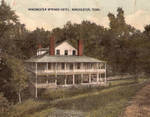
|
Cowan: Gateway to the Summer Resorts By L. Jarod Pearson
Summer resorts and natural springs were a trendy aspect of the travel and transportation industry in the late 19th Century and the early 20th Century. Considering the vast, natural beauty of our area it should come as no surprise that some of the largest and most popular resorts and spas in the entire South were located near Cowan. We can say with pride that our railroad depot served as an important gateway to the resorts located in the mountains above us. There were so many resorts in our area that the Nashville, Chattanooga, and St. Louis Railway (N., C. & St. L) published an annual brochure and travel guide. Cowan is mentioned in the 1912 guide as “among the beautiful foothills of the Cumberlands...the junction where passengers to the Tracy City branch leave the main line of the N., C. & St. L Ry. for the mountain resorts, Sewanee, Monteagle, Tracy City, and Beersheba Springs.” The popularity of mountain resorts was based on several important variables. Air conditioning was virtually unknown in the early 1900's, and summer heat was especially rough on city dwellers, not to mention the unclean air. The threat of malaria was another great concern to people living in cramped urban quarters. The mountains of Tennessee provided the perfect escape, not to mention some of the country's most beautiful scenery. Higher elevations in the Cumberlands provide cooler weather and cleaner air accentuated by a thick canopy of hardwood trees and an undergrowth of leafy branches and other flora. The mountain wilderness was truly an escape from the noise, hustle and bustle of the city and provided plenty of rest and relaxation for weary bones. There were also natural springs with mineral content believed to cure ailments and prevent disease. The 1912 summer resorts guide describes Sewanee on the Mountain “not only as an educational point, but as a health and pleasure resort it is unsurpassed in the South.” The hotel in Sewanee is described as “one of the best as to modern equipment and service, with good and wholesome food”. It was a perfect getaway for thousands of people through the years. In the early 1900's, Monteagle was one of the largest resort towns in the South, so much that three entire pages of the 1912 guide are devoted to Monteagle's many attributes. At the center of it all was Monteagle Sunday School Assembly, founded in 1882 as a resort and education center based on the Chautauqua Institution in New York. Every summer, hundreds of visitors came to the Assembly for lectures and activities emphasizing spiritual, educational, health and cultural topics. Some visitors stayed in small cottages on the Assembly Grounds while others stayed in any number of boarding houses, including the famous Edgewood Inn, or in the unusually large Assembly Inn hotel. Beersheba Springs is much older than Monteagle as it namesake mineral springs were discovered in 1833. A summer resort opened there in 1839 with a hotel and log cabins. The proximity to the Collins River made Beersheba a "fisherman's delight" according to the 1912 summer resort guide. A large and luxurious hotel was built in 1854 to accommodate more than 300 guests. As Cowan residents, we can look at the history and success of the mountain resorts at Sewanee, Monteagle and Beersheba Springs and understand the vital role of our train depot. For at least eight decades rail passengers bound for cooler temperatures and beautiful scenery made their connection at Cowan. Some would board a mixed freight/passenger train for the steep, curvy ride up the mountain. In later years, passengers who didn't have time to wait for the train could hire a taxi right outside the Cowan depot and ride to any of the famous mountain top destinations. Cowan made a wonderful first and last impression for so many people visiting our area. Today, the summer resorts at Monteagle and Beersheba Springs are alive and well and Sewanee has grown to a stronger position as an educational institution. As the years go by, more and more hotels, cabins and summer homes are being built on the mountains above us. Although Cowan no longer has a rail station, we hope that our community will grow in its appeal to travelers and still serve as a gateway to the Mountain. Other Interesting Facts: Not all summer resorts were on the Mountain. Our area had several of these in the valley as well. Estill Springs was famous for its mineral and sulfur springs that travelers could enjoy from the comfort of one of three famous hotels. Near Estill Springs was a small resort known as East Brook on the Elk where the "Green Water" was believed to cure stomach ailments.
East Brook on the Elk Winchester Springs had a large hotel with access to another set of natural springs believed to have medicinal power.
Winchester Springs hotel South of Tullahoma in northern Franklin County was a place called Pylant Springs with cabins and an entire natural water system with at least several distinctive tastes: Saline (green), Sulfur, White Sulfur, Chalybeate, Epsom, Pylant, Lithia, and Freestone. Legend holds that Jesse James and his brother Frank stayed there.
Pylant Springs Further to the west in Lincoln County was a resort known as Crystal Springs with lodges, a dance hall, and access to mineral springs. Links to other websites: Monteagle Sunday School Assembly Tennessee State Library and Archives: Retreat to Tennessee's Historic Resorts <-----Back to the History Page
|


